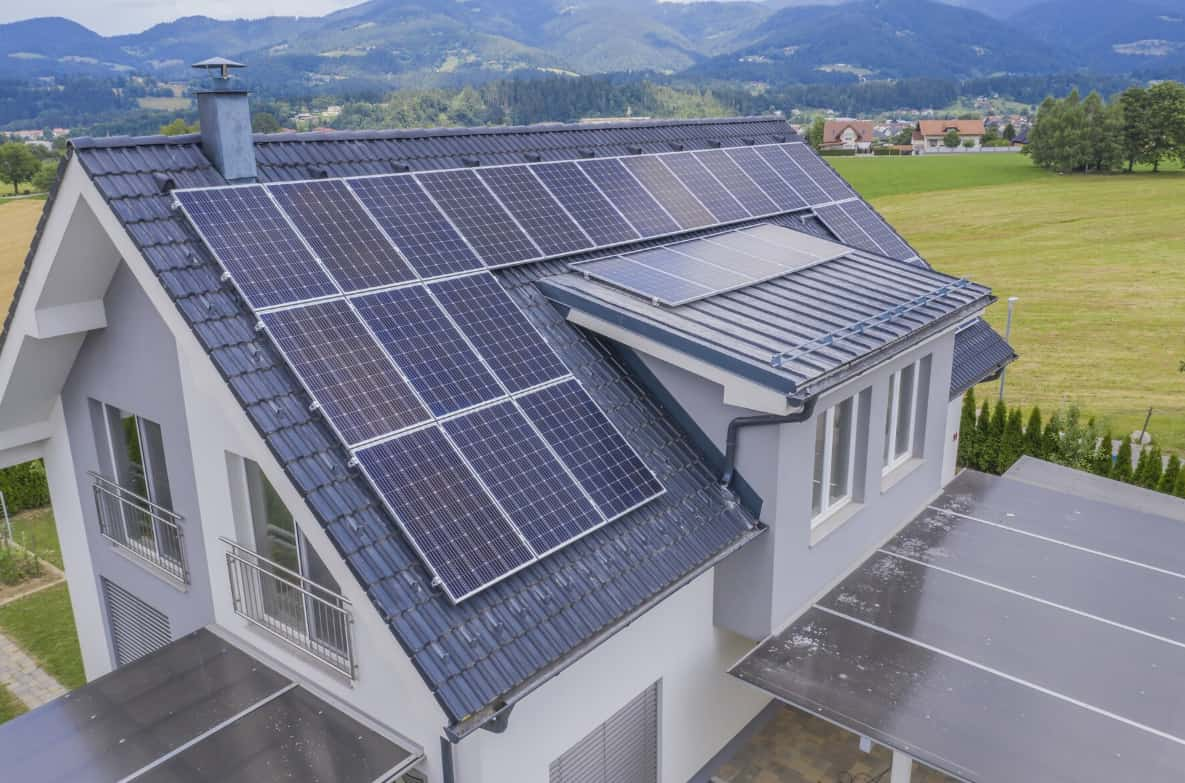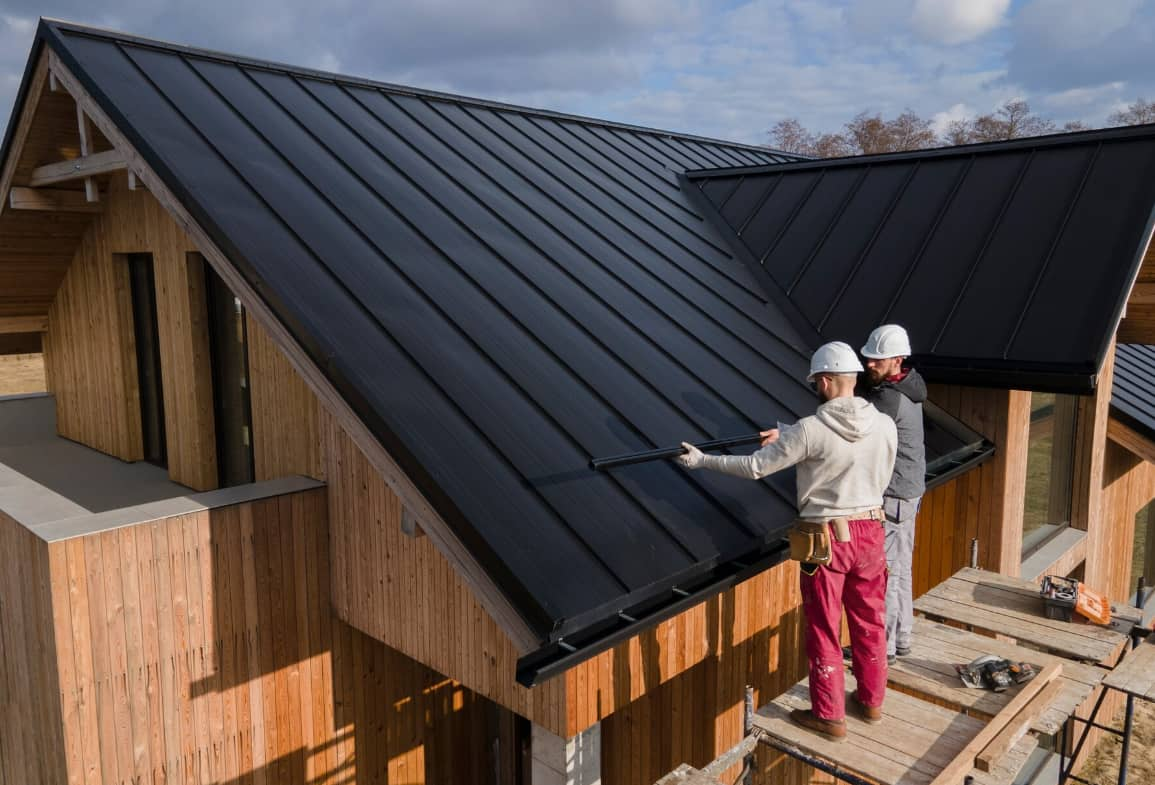Chain link fences are popular because they’re affordable, durable, and do a great job at marking property lines and keeping pets safely contained.
But they have one major downside – they offer zero privacy. If you’re looking for inexpensive ways to cover a chain link fence and gain some privacy in your yard, you’ve come to the right place.
Whether you want to block the view from nosy neighbors, create a more peaceful backyard retreat, or simply improve the look of your outdoor space, there are plenty of budget-friendly options available.
The good news is that you don’t need to tear down your existing fence and start over. With a bit of creativity and some simple materials, you can transform your see-through chain link fence into a private sanctuary.
Inexpensive Ways To Cover A Chain Link Fence

In this guide, we’ll explore 11 affordable privacy solutions that range from quick weekend projects to longer-term investments.
Some options like privacy screens and slats provide instant results, while others like growing vines may take time but offer beautiful, natural coverage.
We’ll break down the pros and cons of each method, approximate costs, and installation tips so you can choose the best solution for your budget, style preferences, and privacy needs.
Let’s dive into these practical, budget-friendly ways to cover your chain link fence and reclaim your outdoor privacy!
How to Make a Chain Link Fence Private – 11 Ideas
Chain Link Fence Privacy Slats (Plastic)
Privacy slats are one of the most common ways to add privacy to chain link fences. These plastic strips are inserted vertically through the diamond-shaped openings in your fence, effectively blocking the view while maintaining the structure of your existing fence.
Pros of Chain Link Privacy Slats:
- Easy to install – most homeowners can do this as a DIY project
- Durable – especially those with UV inhibitors to prevent sun damage
- Wind-resistant – they hold up well against strong winds
- Color options – available in multiple colors to match your outdoor décor
- Affordable – compared to replacing the entire fence
Cons of Privacy Slats:
- Time-consuming installation – you’ll need to insert about 82 slats per 10-foot section
- Not the most attractive option – they have a distinctly utilitarian look
- Maintenance issues – slats can slip down over time unless you use a bottom locking channel
- Limited side-angle privacy – many brands don’t provide complete visual blockage from angles
For the best results, look for high-quality slats like SoliTube Slats, which feature double-wall construction and bottom locking channels to prevent slipping. These higher-quality options might cost more initially but will save you maintenance headaches down the road.
Cost of Privacy Fence Slats:
To cover a 10-foot section of 6-foot tall chain link fence, expect to pay between $60 to $150, depending on the quality of slats you choose. Premium options with features like UV protection and bottom locking channels will be on the higher end of this range.
Plastic Privacy Fence Tape Weave
Privacy fence tape is similar to slats but comes in roll form. Instead of inserting individual slats, you weave this flexible plastic tape horizontally through the chain link mesh to create a privacy barrier.
The tape, like FenPro’s Privacy Fence Tape, is typically just under 2 inches wide and comes in rolls of about 250 feet. Each roll covers approximately 40 square feet of fencing.
While the concept is simple, many homeowners find the weaving process quite tedious compared to installing slats. You’ll need to thread the tape in and out of each diamond-shaped opening in your fence, which can be time-consuming but offers a tight, secure fit.
Cost of Privacy Fence Tape:
For a 10-foot section of 6-foot tall chain link fence (60 square feet), you’ll need approximately 1.5 rolls of privacy tape. This translates to around $55 per 10-foot section. While slightly less expensive than quality slats, remember to factor in the extra time needed for installation.
Bamboo Rolls to Cover Up a Chain Link Fence
For a more natural, exotic look, bamboo rolls offer an attractive alternative to plastic privacy solutions. These rolls consist of full bamboo poles held together with galvanized wire and can be easily attached to your chain link fence using zip ties or wire.
Advantages of Bamboo Rolls as a Privacy Screen:
- Excellent privacy – tightly spaced bamboo poles block views effectively
- Eco-friendly – bamboo is a sustainable, fast-growing grass
- Tropical aesthetic – creates a resort-like atmosphere in your yard
- Simple installation – just unroll it against your fence and secure it with zip ties
- Natural appearance – blends better with landscaping than plastic options
Disadvantages of Bamboo Rolls:
- Color changes – bamboo can fade or change color when exposed to weather
- Maintenance required – may need cleaning and staining to prevent degradation
- Durability concerns – can crack and degrade over time without proper care
- Higher cost – more expensive than plastic privacy options
Installation tip: To extend the life of your bamboo screen, elevate it slightly off the ground to prevent moisture damage to the bottom of the poles.
Cost of Bamboo Rolls for Privacy:
To cover a 10-foot section of 6-foot tall chain link fence, expect to pay $150 or more for rolls made of full bamboo poles. Rolls made of split bamboo strands are available at a lower price point but won’t provide the same durability or appearance.
Reed Screens
Similar to bamboo rolls but made from reed grasses, these natural screens offer another option for covering chain link fences. Reed screens consist of tightly connected reeds that create a rustic, natural-looking barrier when attached to your fence.
Pros of Reed Fence Covering:
- Quick and easy installation – simply unroll and secure to your fence
- Natural appearance – provides an organic look to your yard
- Good privacy – tightly packed reeds block views effectively
- Lightweight – easier to handle than some heavier options
- Eco-friendly material – uses natural plant material
Cons of Reed Fences:
- Limited lifespan – typically needs replacement every 2-3 years
- Color fading – natural material will weather and change appearance over time
- Weather sensitivity – can degrade in extreme weather conditions
- Maintenance needs – may require occasional treatment to extend life
Reed screens make a good temporary solution while you wait for more permanent privacy options like vines to grow, or when you want a natural look without a long-term commitment.
Artificial Hedge Rolls to Add Privacy to a Chain Link Fence
If you want the look of greenery without the wait or maintenance of real plants, artificial hedge rolls offer an attractive solution. These plastic plant screens mimic ivy and other foliage, adding both color and privacy to your chain link fence.
Products like the TANG SunShades artificial faux ivy privacy fence screen attach easily to chain links with zip ties and provide instant green coverage. The synthetic materials are designed to resist UV damage and maintain their appearance for years.
Cost of Artificial Hedge Rolls:
For a 6-foot tall, 10-foot long section of chain link fence, expect to pay approximately $100 for quality artificial hedge rolls. While more expensive than basic privacy options like slats or tape, they provide a much more attractive appearance.
| Privacy Option | Cost per 10ft section (6ft tall) | Installation Difficulty | Durability | Appearance |
|---|---|---|---|---|
| Privacy Slats | $60-$150 | Moderate | Good | Basic |
| Privacy Tape | $55 | Difficult | Good | Basic |
| Bamboo Rolls | $150+ | Easy | Fair | Natural |
| Reed Screens | $70-$100 | Easy | Poor | Natural |
| Artificial Hedge | $100 | Easy | Good | Decorative |
Expandable Artificial Hedge Panels
For a more structured approach to faux greenery, expandable artificial hedge panels offer flexibility and ease of installation. These panels feature artificial foliage attached to a willowwood framework that expands and contracts like an accordion.
The expandable nature allows you to adjust the coverage to fit your specific fence dimensions. When fully contracted, these panels provide dense privacy screening, while expanding them creates a more open but still decorative barrier.
Installation is straightforward: simply expand the panel to the desired width, position it against your chain link fence, and secure it with zip ties through the wooden framework.
Note: The more you stretch these expandable panels, the less privacy they provide as the fake leaves spread out. For maximum privacy, use them at their most compressed width.
While prices vary by manufacturer and quality, expect to pay between $80-$200 per panel depending on the size and density of the artificial foliage.
Grow Fast-Growing Vines Up Your Fence
For a truly natural privacy solution that improves with time, fast-growing vines offer an excellent option. With proper care, climbing vines can transform your chain link fence into a lush, living wall of greenery.
Some popular fast-growing vine options include:
- Wisteria – produces beautiful purple flowers but can be aggressive
- Climbing Hydrangea – features attractive white flower clusters
- Virginia Creeper – offers a dramatic red fall color
- Star Jasmine – provides fragrant white flowers
- Boston Ivy – creates dense coverage with minimal maintenance
Benefits of using vines:
- Continuous improvement – privacy increases as plants grow
- Ecological benefits – provides habitat for birds and insects
- Cooling effect – can help reduce temperatures around your home
- Changing seasons – offers different looks throughout the year
- Long-term solution – can last for decades with proper care
Drawbacks to consider:
- Patience required – takes time to establish full coverage
- Maintenance needs – regular pruning may be necessary to control growth
- Potential damage – some aggressive vines may damage the fence over time
- Seasonal changes – deciduous vines lose leaves in winter (choose evergreen varieties for year-round privacy)
While waiting for vines to grow, you might want to use a temporary privacy solution from elsewhere on this list. The initial cost for vines is relatively low ($10-$30 per plant), but you’ll need to space them appropriately along your fence line for proper coverage.
Planter Boxes Along the Top of the Fence
For a unique approach to privacy, consider installing planter boxes along the top of your chain link fence. This method allows you to grow trailing plants that cascade down the fence, creating a curtain of greenery.
How to implement this solution:
- Select sturdy planter boxes designed for railing mounting
- Securely attach them to the top rail of your chain link fence
- Fill with quality potting soil
- Plant trailing varieties like Silver Falls (Dichondra argentea), ivy, or trailing petunias
- Water and maintain regularly
Benefits of planter boxes:
- Unique appearance – creates a distinctive look for your yard
- Flexibility – can change plants seasonally
- Space efficiency – utilizes vertical space without taking up ground area
- Customizable coverage – choose plants based on how much privacy you need
Considerations:
- Weight – ensure your fence can support the weight of planters, soil, and plants
- Maintenance – requires regular watering and plant care
- Weather factors – may need more frequent watering in hot weather
The cost varies depending on the type and number of planters, plus plant materials. Budget $15-$30 per linear foot for a basic setup, with premium planters and plants costing more.
Privacy Lattice to Cover Your Fence
Lattice panels, available in both wood and plastic varieties, provide another option for covering chain link fences. “Privacy lattice” features smaller openings than standard lattice, providing better screening while maintaining an attractive pattern.
Advantages of Lattice:
- Decorative appearance – adds architectural interest
- Light and air flow – allows some breeze while blocking views
- Plant support – provides a structure for climbing plants
- Easy installation – attaches to chain link with zip ties
- Customizable – can be painted to match your color scheme
Disadvantages of Lattice:
- Partial privacy – still has openings, though smaller than chain link
- Size limitations – standard panels are 4′ x 8′, which may require cutting
- Maintenance – wood lattice needs regular painting or staining
- Waste concerns – cutting panels to fit may result in material waste
Installation challenge: Since most chain link fence sections are 10 feet wide (between posts) and lattice panels are typically 8 feet long, you’ll need to plan carefully to avoid excessive waste or awkward joints.
Cost of Lattice Panels:
For vinyl privacy lattice panels (4′ x 8′), expect to pay around $40-$45 per panel. Wood lattice may be slightly less expensive initially but will require ongoing maintenance costs. For a 6-foot tall, 10-foot section of fence, you would need approximately 1.25 panels (assuming vertical orientation).
Chain Link Fence Privacy Screens (A Popular Choice)
Privacy screens or windscreens offer perhaps the quickest and easiest solution for covering chain link fences. These fabric-like materials come in large sheets with grommets along the edges for easy attachment.
Made from durable, weather-resistant materials like polyethylene, these screens simply tie to your existing fence using zip ties. Popular options like Windscreen4less and Amgo screens claim to block 90% of visibility while still allowing some air to pass through.
Benefits of privacy screens:
- Fast installation – can cover large fence sections quickly
- Excellent privacy – high blockage percentage
- Low maintenance – generally weather-resistant
- Color options – available in multiple colors to match your landscape
- Affordable coverage – cost-effective for large areas
Considerations:
- Wind stress – in high-wind areas, ensure proper attachment
- Appearance – more utilitarian look than decorative options
- Durability – quality varies by manufacturer
- Replacement needs – may need replacement every few years depending on weather exposure
For a 6-foot tall, 50-foot long privacy screen with grommets and zip ties included, expect to pay between $80-$120, making this one of the most cost-effective solutions for covering large fence sections.
What About Wooden Fence Panels?
While attaching wooden fence panels to your chain link fence might seem like a straightforward solution, there are several important considerations before pursuing this option.
Structural concerns:
- Weight issues – standard residential chain link fences may not support the weight of wood
- Post strength – typical 16-gauge chain link posts (1.65mm wall thickness) are too thin for wood panel support
- Wind load – unlike chain link which allows wind to pass through, solid wood creates significant wind resistance
Practical challenges:
- Spacing mismatch – chain link posts are typically 10 feet apart, while standard wood panels are 8 feet wide
- Ground contact – wood panels touching the ground may rot quickly
- Installation complexity – requires more advanced carpentry skills
If you’re still interested in using wood, consider these alternatives:
- Install vertical 2×6 boards alongside existing posts, with the boards resting on the ground to support the weight
- Use thin wooden slats or rails instead of full panels to reduce weight and wind resistance
- Consult a professional fencing company to evaluate your existing fence structure
Professional tip: Before adding wood to your chain link fence, have a fencing professional measure your post thickness. If posts are less than 0.085″ (2.16mm) thick, you’ll likely need to install new, heavier-duty posts to support wooden privacy panels.
FAQs
- How much does it cost to make a chain link fence private?
The cost ranges from $55-$150 per 10-foot section for most DIY options like privacy slats, screens, or artificial hedges. Natural options like vines can be less expensive initially but take time to establish.
- What is the cheapest way to cover a chain link fence?
Privacy fence tape is typically the least expensive option at around $55 per 10-foot section. Growing vines can be even more affordable over time, with initial plants costing $10-$30 each.
- How long do chain link fence privacy options last?
Durability varies widely: high-quality plastic slats and screens can last 7-10 years, while natural materials like reeds may need replacement every 2-3 years. Vines and plants can provide decades of coverage with proper maintenance.
- Can I install privacy features on a rental property?
Yes, many options like screens and artificial hedges attach with zip ties and can be removed without damaging the fence, making them suitable for rentals. Always check with your landlord first.
- Which privacy option is best for windy areas?
Privacy slats typically perform best in windy conditions as they allow some air to pass through while still providing privacy. Full panels or screens may create more wind resistance and stress on your fence.
- Do I need permits to add privacy features to my chain link fence?
Generally, adding privacy features to an existing fence doesn’t require permits, but always check local regulations, especially if significantly changing the fence’s appearance or height.
Also Check:
Conclusion:
Transforming your chain link fence into a private retreat doesn’t have to break the bank or require specialized skills.
From quick solutions like privacy screens and slats to natural options like vines and bamboo, there’s an affordable option to suit every yard, budget, and aesthetic preference.
When choosing the right privacy solution for your fence, consider:
- Your budget – both initial costs and long-term maintenance
- Desired level of privacy – complete blockage or partial screening
- Aesthetic preferences – natural, decorative, or functional
- Installation effort – quick weekend project or longer-term investment
- Durability needs – temporary solution or permanent privacy
The best part about these privacy options is that they allow you to keep your sturdy, functional chain link fence while addressing its main drawback – lack of privacy.
With some creativity and minimal investment, you can transform that see-through barrier into a private, personalized boundary that enhances your outdoor living space.
Whether you choose the quick installation of a privacy screen, the natural beauty of climbing vines, or the structured look of privacy slats, your newly private chain link fence will give you the seclusion you desire without the expense of complete fence replacement.













